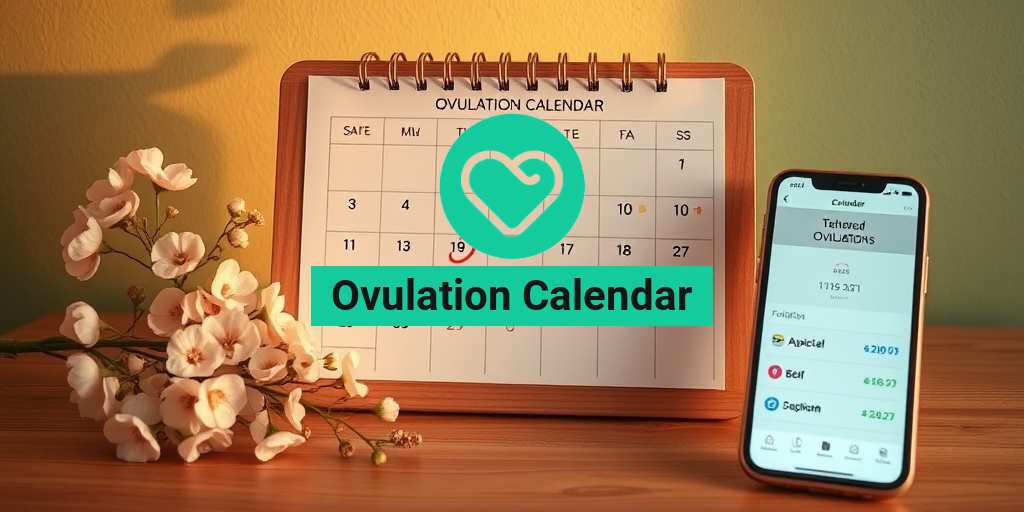What Is an Ovulation Calendar?
An ovulation calendar is a valuable tool designed to help individuals track their menstrual cycles and identify their fertile days. Understanding your ovulation cycle is crucial for those trying to conceive, as it pinpoints the optimal time for conception. But even if you’re not looking to get pregnant, knowing your ovulation schedule can provide insights into your overall reproductive health.
Understanding Ovulation
Ovulation occurs when an ovary releases an egg, typically around the midpoint of your menstrual cycle. For most women with a regular 28-day cycle, ovulation happens around day 14. However, cycles can vary significantly, ranging from 21 to 35 days. This variability is where an ovulation calendar becomes essential, as it helps you tailor your tracking to your unique cycle.
Benefits of Using an Ovulation Calendar
- Increased Awareness: By tracking your cycle, you become more aware of your body’s rhythms and changes.
- Fertility Tracking: If you’re trying to conceive, knowing your ovulation days can significantly increase your chances of pregnancy.
- Health Monitoring: An ovulation calendar can help identify irregularities in your cycle, which may indicate underlying health issues.
- Planning Ahead: Understanding your cycle can assist in planning vacations, events, or even managing symptoms associated with menstruation.
How to Use an Ovulation Calendar
Using an ovulation calendar is straightforward, but it requires consistency and attention to detail. Here’s a step-by-step guide to help you get started:
Step 1: Track Your Menstrual Cycle
Begin by marking the first day of your period on the calendar. This is considered day one of your cycle. Continue to track each day of your cycle, noting when your period starts and ends. If your cycle is irregular, it may take a few months to establish a pattern.
Step 2: Identify Your Cycle Length
Count the total number of days from the first day of your period to the day before your next period starts. This will give you your cycle length. Most women have a cycle length between 21 and 35 days. If you have a 30-day cycle, for example, ovulation typically occurs around day 16.
Step 3: Calculate Your Ovulation Days
To find your ovulation window, subtract 14 days from your cycle length. For a 30-day cycle, ovulation would occur around day 16. Mark this on your calendar. Remember, sperm can live in the female reproductive tract for up to five days, so it’s beneficial to have intercourse a few days before and on the day of ovulation for the best chances of conception.
Step 4: Use an Ovulation Calendar App
For those who prefer a digital approach, there are numerous ovulation calendar apps available, many of which are free. These apps can simplify tracking by allowing you to input your cycle data and receive notifications about your fertile days. Some popular options include Clue, Flo, and Ovia. These apps often come with additional features, such as symptom tracking and health insights, making them a comprehensive tool for reproductive health.
Step 5: Monitor Your Symptoms
Pay attention to your body’s signals during your cycle. Many women experience physical signs of ovulation, such as changes in cervical mucus, mild cramping, or breast tenderness. Recording these symptoms can enhance the accuracy of your ovulation calendar and provide further insights into your reproductive health.
Step 6: Consult with a Healthcare Provider
If you have concerns about your menstrual cycle or fertility, consider consulting with a healthcare provider. They can provide personalized advice and may recommend additional methods for tracking ovulation, such as ovulation predictor kits.
In conclusion, an ovulation calendar is a powerful tool for anyone looking to understand their menstrual cycle better. Whether you’re trying to conceive or simply want to monitor your reproductive health, this calendar can provide valuable insights. For more evidence-based health answers, consider visiting Yesil Health AI, a resource dedicated to providing accurate health information.
By taking the time to track your cycle, you empower yourself with knowledge about your body, leading to better health outcomes and informed decisions. 🌸

Signs of Ovulation
Understanding the signs of ovulation is crucial for anyone trying to conceive or simply wanting to track their menstrual cycle. Ovulation is the process where an ovary releases an egg, and it typically occurs midway through your cycle. Here are some common signs that indicate you are ovulating:
1. Changes in Cervical Mucus
One of the most noticeable signs of ovulation is a change in cervical mucus. As you approach ovulation, your body produces more estrogen, which leads to an increase in cervical mucus. This mucus becomes clear, stretchy, and resembles raw egg whites. This change helps sperm travel more easily to the egg, increasing the chances of conception.
2. Basal Body Temperature Rise
Your basal body temperature (BBT) is your body’s temperature at rest. Just after ovulation, there is a slight increase in BBT due to the hormone progesterone. Tracking your BBT daily can help you identify when you have ovulated. A rise of about 0.5 to 1 degree Fahrenheit can indicate that ovulation has occurred.
3. Ovulation Pain
Some women experience a sharp pain or cramping on one side of their lower abdomen during ovulation, known as mittelschmerz. This pain can last from a few minutes to a few hours and is a direct sign that your ovary has released an egg.
4. Increased Libido
Many women notice an increase in sexual desire around the time of ovulation. This natural boost in libido is your body’s way of encouraging reproduction during your most fertile days.
5. Breast Tenderness
Hormonal changes during ovulation can lead to breast tenderness or sensitivity. If you notice your breasts feel fuller or more sensitive around the middle of your cycle, it could be a sign that you are ovulating.
6. Light Spotting
Some women may experience light spotting or bleeding during ovulation, known as ovulation bleeding. This can occur when the follicle ruptures to release the egg. If you notice a small amount of blood or pinkish discharge, it might be a sign of ovulation.
Ovulation Cycle Phases
The ovulation cycle is divided into several phases, each playing a vital role in fertility and reproductive health. Understanding these phases can help you better utilize an ovulation calendar to track your cycle effectively.
1. Menstrual Phase
The menstrual phase marks the beginning of your cycle, lasting about 3 to 7 days. During this time, the uterine lining sheds if no pregnancy has occurred. This phase is characterized by menstrual bleeding and can be accompanied by symptoms like cramps and mood swings.
2. Follicular Phase
Following menstruation, the follicular phase begins and lasts until ovulation. During this phase, the pituitary gland releases follicle-stimulating hormone (FSH), which stimulates the growth of ovarian follicles. One follicle will mature into an egg, while the others will disintegrate. This phase typically lasts about 14 days but can vary depending on the length of your cycle.
3. Ovulation Phase
The ovulation phase is the peak of fertility. Triggered by a surge in luteinizing hormone (LH), ovulation usually occurs around day 14 in a typical 28-day cycle. The mature egg is released from the ovary and is available for fertilization for about 12 to 24 hours. This is the best time to conceive, making it essential to track this phase using an ovulation calendar.
4. Luteal Phase
After ovulation, the luteal phase begins and lasts about 14 days. The ruptured follicle transforms into the corpus luteum, which produces progesterone to prepare the uterine lining for a potential pregnancy. If fertilization does not occur, hormone levels drop, leading to the start of the menstrual phase again.
5. Tracking Your Cycle
Using an ovulation calendar can help you identify these phases and predict your fertile window. Many women find it helpful to use an ovulation calendar app, which can provide reminders and insights based on your cycle length. Whether you have a 30-day cycle or a different length, these tools can assist you in understanding your body better.
By recognizing the signs of ovulation and understanding the phases of your cycle, you can take control of your reproductive health and make informed decisions about family planning. 🌼

Factors Affecting Ovulation
Understanding the factors that influence ovulation is crucial for anyone looking to conceive or simply track their menstrual cycle. Ovulation is a complex process affected by various internal and external factors. Here, we’ll explore some of the most significant elements that can impact ovulation.
1. Hormonal Balance
The menstrual cycle is regulated by a delicate balance of hormones, including estrogen and progesterone. Any disruption in these hormone levels can lead to irregular ovulation. Conditions such as polycystic ovary syndrome (PCOS) or thyroid disorders can significantly affect hormonal balance, leading to missed or irregular ovulation.
2. Age
Age plays a vital role in a woman’s fertility and ovulation patterns. As women age, particularly after the age of 35, the quality and quantity of eggs decline, which can lead to irregular ovulation. Understanding your age-related fertility can help in planning for pregnancy.
3. Stress Levels
High levels of stress can have a profound impact on ovulation. Stress triggers the release of cortisol, which can interfere with the hormones responsible for ovulation. Finding effective stress management techniques, such as yoga or meditation, can help maintain a regular ovulation cycle.
4. Body Weight
Both underweight and overweight conditions can disrupt ovulation. A body mass index (BMI) that is too low can lead to hormonal imbalances, while obesity can cause insulin resistance, affecting ovulation. Maintaining a healthy weight is essential for regular menstrual cycles and ovulation.
5. Lifestyle Choices
Your lifestyle choices, including diet, exercise, and substance use, can also influence ovulation. A balanced diet rich in nutrients supports hormonal health, while regular exercise can help maintain a healthy weight. Conversely, smoking and excessive alcohol consumption can negatively affect fertility and ovulation.
6. Medical Conditions
Certain medical conditions can interfere with ovulation. Conditions like endometriosis, pelvic inflammatory disease, and uterine fibroids can cause pain and hormonal imbalances, leading to irregular ovulation. If you suspect any underlying health issues, consulting a healthcare provider is essential.
Benefits of Tracking Ovulation
Tracking ovulation can provide numerous benefits, especially for those trying to conceive or manage their reproductive health. Here are some key advantages of using an ovulation calendar:
1. Improved Fertility Awareness
By tracking ovulation, you can identify your most fertile days, increasing your chances of conception. An ovulation calendar helps pinpoint the optimal time for intercourse, making it easier to conceive.
2. Understanding Your Cycle
Using an ovulation calendar allows you to gain insights into your menstrual cycle. You can recognize patterns, such as cycle length and symptoms associated with ovulation, which can be beneficial for overall reproductive health.
3. Early Detection of Irregularities
Regularly tracking ovulation can help you notice any irregularities in your cycle. If you observe significant changes, such as missed periods or unusual symptoms, it may be time to consult a healthcare professional.
4. Natural Family Planning
For those looking to avoid pregnancy, an ovulation calendar can be a valuable tool for natural family planning. By understanding when ovulation occurs, you can make informed decisions about contraception.
5. Enhanced Communication with Healthcare Providers
Having a detailed record of your ovulation patterns can facilitate better discussions with your healthcare provider. This information can help them understand your reproductive health and provide tailored advice or treatment options.
6. Access to Technology
With the rise of technology, there are numerous ovulation calendar apps available, many of which are free. These apps can simplify tracking by providing reminders and visual representations of your cycle, making it easier to stay informed.
In conclusion, understanding the factors affecting ovulation and the benefits of tracking it can empower you to take control of your reproductive health. Whether you’re trying to conceive or simply want to understand your body better, an ovulation calendar can be an invaluable resource. 🌸

Ovulation Calendar Apps
In today’s digital age, tracking your ovulation has never been easier, thanks to a variety of ovulation calendar apps. These apps not only help you understand your menstrual cycle but also assist in planning for pregnancy or avoiding it. Let’s explore some of the best features and benefits of using these apps.
What is an Ovulation Calendar App?
An ovulation calendar app is a mobile application designed to help users track their menstrual cycles, predict ovulation days, and identify fertile windows. By inputting data such as cycle length and period start dates, these apps can provide personalized insights into your reproductive health.
Top Features of Ovulation Calendar Apps
- Cycle Tracking: Most apps allow you to log your menstrual cycle, making it easy to see patterns over time.
- Fertility Predictions: They can predict your ovulation days and fertile windows, which is crucial for those trying to conceive.
- Health Insights: Many apps offer insights into symptoms, moods, and other health factors that can affect your cycle.
- Reminders: Set reminders for when to take ovulation tests or when your next period is due.
- Community Support: Some apps provide forums or community features where users can share experiences and advice.
Popular Ovulation Calendar Apps
Here are a few highly-rated ovulation calendar apps that you might consider:
- Clue: Known for its user-friendly interface and scientific approach, Clue helps track your cycle and provides personalized insights.
- Flo: This app not only tracks your cycle but also offers health articles and community support.
- Ovia: Ovia is great for those trying to conceive, offering fertility predictions and health tracking features.
- Glow: Glow combines cycle tracking with community support, making it a popular choice among users.
Many of these apps are available for free, with optional premium features for more in-depth tracking and insights. Whether you’re looking to conceive or simply want to understand your body better, an ovulation calendar app can be a valuable tool. 📱✨
Common Myths About Ovulation
When it comes to ovulation, there are numerous myths and misconceptions that can lead to confusion. Understanding the truth behind these myths is essential for anyone looking to manage their reproductive health effectively. Let’s debunk some of the most common myths about ovulation.
Myth 1: You Can Only Get Pregnant on the Day of Ovulation
Many people believe that the only time you can conceive is on the day of ovulation. However, sperm can live inside the female reproductive tract for up to five days. This means that having intercourse in the days leading up to ovulation can also result in pregnancy. 🌟
Myth 2: Ovulation is Always the Same Day Each Cycle
While ovulation typically occurs around the midpoint of your cycle, it can vary from month to month due to various factors such as stress, illness, or changes in routine. Using an ovulation calendar can help you track these variations more accurately.
Myth 3: You Can’t Ovulate if You’re on Birth Control
Many forms of hormonal birth control work by preventing ovulation. However, if you stop taking birth control, your body may take some time to resume its natural ovulation cycle. It’s important to consult with a healthcare provider for guidance on what to expect when discontinuing birth control.
Myth 4: Ovulation Symptoms are the Same for Everyone
While some women experience noticeable symptoms during ovulation, such as mild cramping or changes in cervical mucus, others may not notice any symptoms at all. Each body is unique, and understanding your own cycle is key to recognizing your ovulation signs.
Myth 5: Ovulation Only Matters for Women Trying to Conceive
Even if you’re not trying to get pregnant, understanding your ovulation cycle can provide valuable insights into your overall health. It can help you track your menstrual cycle, manage symptoms, and even predict when your period will start. 🩸
By debunking these myths, you can gain a clearer understanding of your reproductive health and make informed decisions about your body. Remember, knowledge is power! 💪

Frequently Asked Questions about Ovulation Calendar
What is an Ovulation Calendar?
An ovulation calendar is a tool that helps track a woman’s menstrual cycle to predict ovulation days. This can be particularly useful for those trying to conceive or avoid pregnancy.
How do I use an Ovulation Calendar?
To use an ovulation calendar, you need to record the first day of your menstrual cycle for several months. This data helps you identify patterns and predict your ovulation days.
Can I find a free Ovulation Calendar app?
Yes! There are many ovulation calendar apps available for free. These apps often provide additional features like reminders and fertility tracking.
What if my cycle is irregular?
If you have an irregular cycle, using an ovulation calendar may be more challenging. It’s advisable to consult with a healthcare provider for personalized advice.
Are there specific Ovulation Calendars for different cycle lengths?
Yes, there are ovulation calendars designed for various cycle lengths, including those for a 30-day cycle. You can find templates or apps that cater to your specific needs.
Can I use an Ovulation Calendar to choose the gender of my baby?
Some people believe that timing intercourse based on an ovulation calendar can influence the gender of the baby. However, scientific evidence supporting this is limited.
Is there an Ovulation Calendar available in different languages?
Yes, you can find ovulation calendars in various languages, including Telugu and Hindi, to cater to a wider audience.
What is an example of an Ovulation Calendar?
An ovulation calendar example typically includes a grid where you can mark the start of your period, ovulation days, and fertile windows. Many online resources provide printable versions.
How does an Ovulation Calendar relate to fertility?
Using an ovulation calendar can enhance your understanding of your fertility window, making it easier to conceive or avoid pregnancy during your most fertile days.
Where can I find an Ovulation Calendar chart?
You can find ovulation calendar charts online, in fertility books, or through various health apps. These charts visually represent your cycle and ovulation days.




